
What is Petrovite? Petrovite is a striking blue mineral discovered in Russia. Named after Russian mineralogist Dr. Dmitry Petrov, it’s found in the Tolbachik volcano. This mineral is unique because it contains copper, oxygen, sulfur, and sodium. Why is Petrovite special? Its crystal structure allows it to conduct ions, making it potentially useful in battery technology. Where can you find Petrovite? Currently, it’s only found in the Kamchatka Peninsula. How was it discovered? Scientists stumbled upon it while studying volcanic rocks. What makes it blue? The presence of copper gives Petrovite its vibrant color. Is Petrovite rare? Yes, due to its limited location.
Key Takeaways:
- Petrovite, a rare blue mineral found in volcanic fumaroles, has a unique crystal structure that can trap small molecules. It's named after Dr. Anatoly Petrov and has potential uses in gas storage and environmental science.
- Discovered in 2000 during a volcanic eruption, Petrovite is fragile, fluoresces under UV light, and has a vitreous luster. It's a prized specimen for collectors and is used to teach students about mineralogy and volcanic processes.
What is Petrovite?
Petrovite is a fascinating mineral discovered relatively recently. Found in Russia, it has some unique properties that make it stand out. Let's dive into some intriguing facts about this mineral.
-
Petrovite was discovered in 2000. It was named after Russian mineralogist Dr. Anatoly Petrov.
-
It is found in the Tolbachik volcano. This volcano is located on the Kamchatka Peninsula in Russia.
-
Petrovite is a sulfate mineral. It contains sulfur, oxygen, and other elements.
-
The mineral has a bright blue color. This striking hue makes it visually appealing.
-
Petrovite forms in fumaroles. These are openings in the Earth's crust near volcanoes that emit gases.
-
It has a unique crystal structure. The structure is complex and includes channels that can trap small molecules.
Chemical Composition of Petrovite
Understanding the chemical makeup of Petrovite helps us appreciate its unique properties. Here are some key facts about its composition.
-
Petrovite's chemical formula is Na10CaCu2(SO4)8. This indicates it contains sodium, calcium, copper, and sulfate.
-
It contains copper. This element contributes to its blue color.
-
Sodium is a major component. Sodium ions play a crucial role in its structure.
-
Calcium is also present. Calcium ions help stabilize the mineral's structure.
-
Sulfate groups are essential. These groups form the backbone of the mineral's structure.
-
It has a high oxygen content. Oxygen atoms are part of the sulfate groups.
Formation and Occurrence
Petrovite's formation process and where it can be found are equally fascinating. Here are some facts about its occurrence.
-
Forms in high-temperature environments. Petrovite crystallizes at temperatures above 500°C.
-
Found in volcanic fumaroles. These environments provide the necessary conditions for its formation.
-
Tolbachik volcano is the primary source. Most known samples come from this location.
-
Rarely found in large quantities. Petrovite is not abundant and is considered a rare mineral.
-
Associated with other minerals. It often occurs alongside minerals like langbeinite and aphthitalite.
-
Discovered during volcanic expeditions. Researchers found it while studying volcanic activity.
Uses and Applications
While Petrovite is primarily of interest to scientists, it has potential applications. Here are some facts about its uses.
-
Studied for its unique structure. Scientists are interested in its ability to trap small molecules.
-
Potential for gas storage. The channels in its structure could be used to store gases.
-
Interest in its electrical properties. Researchers are exploring its potential as a conductor.
-
Used in mineral collections. Its rarity and beauty make it a prized specimen for collectors.
-
Educational purposes. Petrovite is used to teach students about mineralogy and volcanic processes.
-
Potential in environmental science. Its ability to trap gases could have implications for pollution control.
Interesting Tidbits
Here are some additional fun and lesser-known facts about Petrovite.
-
Named after a prominent scientist. Dr. Anatoly Petrov made significant contributions to mineralogy.
-
Discovered during a volcanic eruption. The Tolbachik volcano was actively erupting when Petrovite was found.
-
Its discovery was accidental. Researchers were not specifically looking for new minerals.
-
Petrovite is fragile. It can easily break or crumble if not handled carefully.
-
It fluoresces under UV light. This property makes it even more interesting to study.
-
Petrovite has a vitreous luster. This gives it a glass-like appearance.
Petrovite's Unique Place in Science
Petrovite's discovery has added a fascinating chapter to mineralogy. Found in the harsh environment of Russia's Kamchatka Peninsula, this blue mineral stands out due to its unique chemical composition and crystal structure. Named after Dr. Stanislav Filatov, Petrovite's potential applications in battery technology could revolutionize energy storage. Its copper sulfate content offers promising avenues for research, especially in sustainable energy solutions.
Understanding Petrovite's properties helps scientists explore new materials for various industries. From its vibrant blue hue to its potential technological uses, Petrovite is more than just a pretty mineral. It's a symbol of how much there is still to learn about our planet. As research continues, who knows what other secrets Petrovite might reveal? This mineral's journey from volcanic rock to scientific marvel is just beginning.
Frequently Asked Questions
Was this page helpful?
Our commitment to delivering trustworthy and engaging content is at the heart of what we do. Each fact on our site is contributed by real users like you, bringing a wealth of diverse insights and information. To ensure the highest standards of accuracy and reliability, our dedicated editors meticulously review each submission. This process guarantees that the facts we share are not only fascinating but also credible. Trust in our commitment to quality and authenticity as you explore and learn with us.
